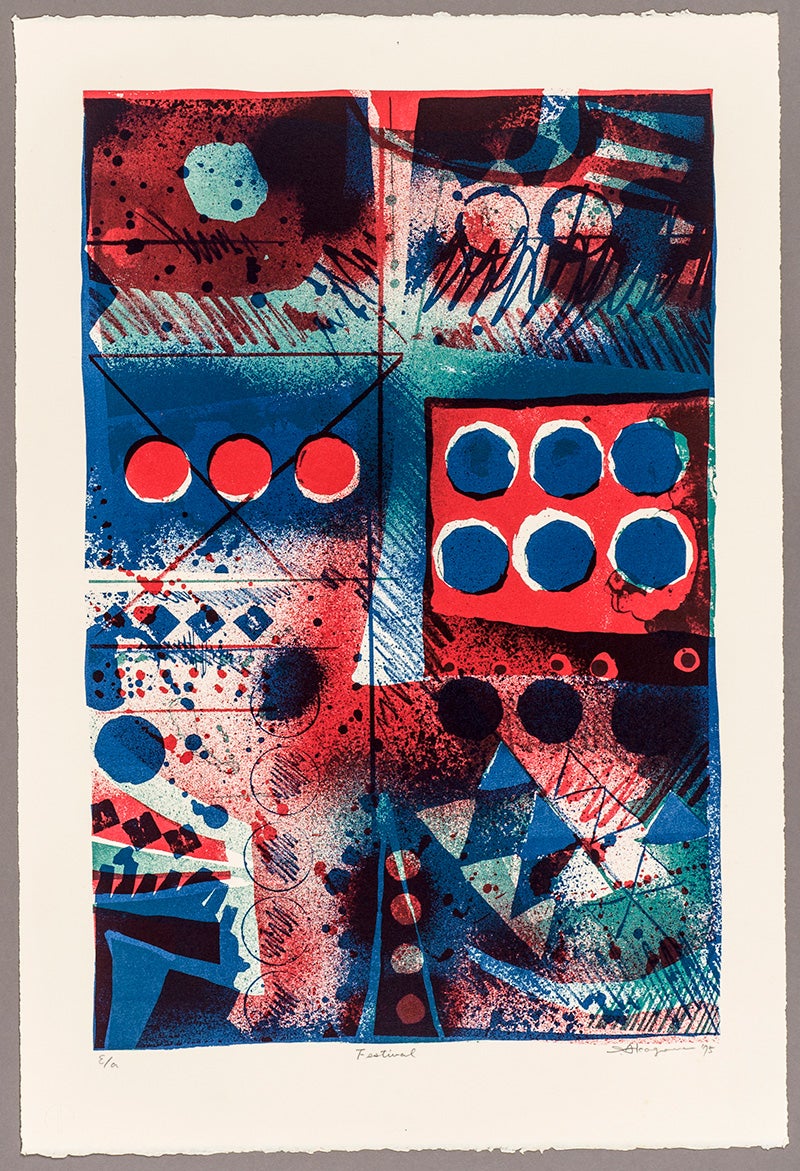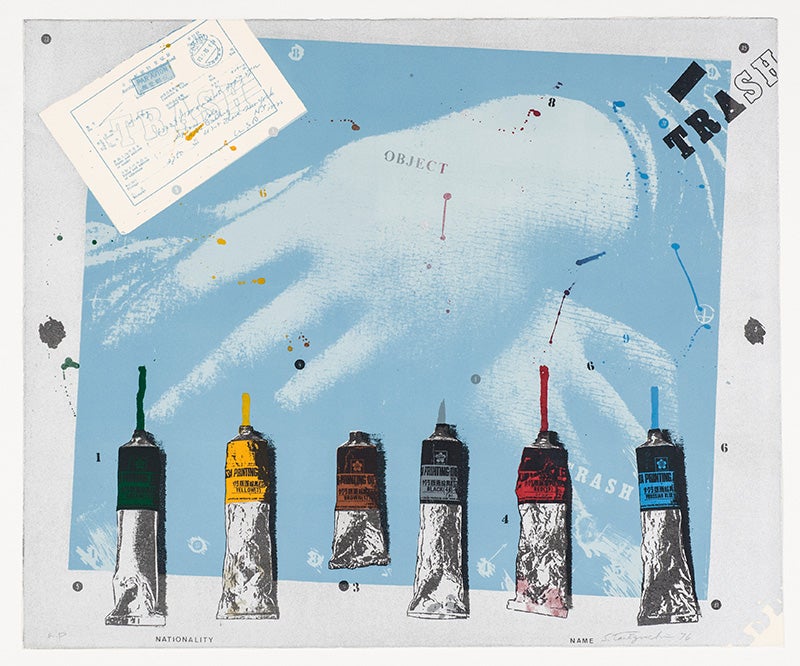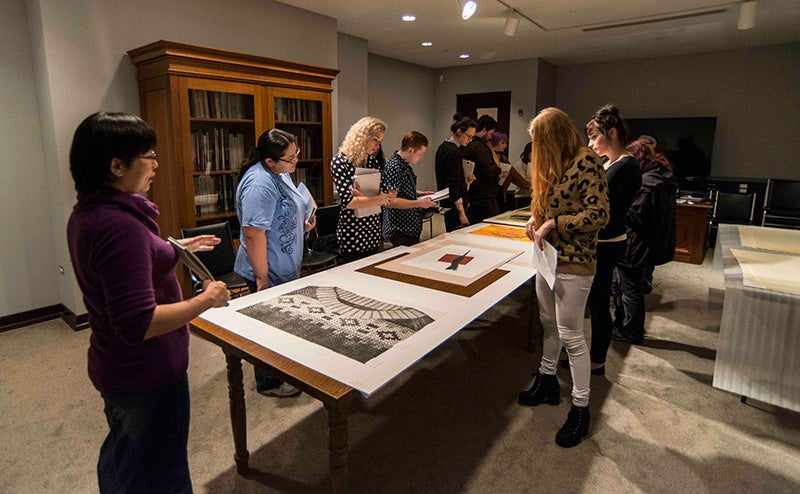After the Jordan Schnitzer Museum of Art (JSMA) received more than 150 Japanese prints from art collectors Jack and Susy Wadsworth, Assistant Professor Akiko Walley initiated a pair of courses leading up to a JSMA exhibition scheduled for fall 2015.
“What is so wonderful about the Wadsworth collection is that it complements the JSMA’s already rich collection of Japanese prints really well,” says Walley, the Maude I. Kerns assistant professor of Japanese art in the Department of the History of Art and Architecture. “Because of that, we’re now able to feature them in a more comprehensive way, to show that Japanese prints are not just about woodblocks, but it’s much, much more.”

Above: Students in Akiko Walley’s class get a first-hand look at Japanese prints. Photo by Jonathan Smith. Courtesy Jordan Schnitzer Museum of Art.
The Wadsworth collection features an array of prints exemplifying the four main techniques of printmaking: lithography, intaglio, relief printing, and screenprinting from both Japanese and Western artists inspired by Japanese prints.
Anne Rose Kitagawa, the chief curator of Collections and Asian Art for the JSMA, notes that the museum was founded for the display and study of traditional Asian art. JSMA has displayed Japanese works of art from the Edo (1615-1868) and Meiji (1868-1912) periods through the Taishô (1912-1926) and early Shôwa (1926-1989) periods, but relatively little of the postwar period. The Wadsworths’ donation, Kitagawa says, has helped rectify this balance.
In Walley’s ARH 399: “Japanese Prints and Their Techniques,” students attend lectures on the history of Japanese printmaking at the Gilkey Research Center in the museum, accompanied by first-hand examination of the Wadsworth prints. The students also took part in five studio sessions in which they received hands-on experience in some of the major printmaking techniques, working in groups or individually to create their own prints. The course’s studio component, offered through a collaboration with the Department of Art, was instructed by Associate Professor Charlene Liu and printmaking and fibers technician Mika Boyd.
“The students have been fantastic. They jump right in, stay on track, and have been unfazed by the technical and creative demands in each short two-hour studio session,” Liu says. “Their prints have been unique and expressive.”

Above: Festival, 1975. AKAGAWA Isao. Lithograph. Gift of the Jack and Susy Wadsworth Collection of Japanese Prints. 2102:7.2
Walley was awarded an $8,000 endowment through the UO’s Tom and Carol Williams Fund for Undergraduate Education for the academic year 2014-2015. The fund allowed Walley to conduct research in Japan last summer in preparation for the course, and supported Liu and Boyd’s participation in the studio.
“Akiko’s proposal intrigued the Williams Council and drew their support because it did a wonderful job of making the treasured resource of the university’s world-class museum of art accessible to our undergraduates,” said David Hubin, senior assistant to the UO President and chair of the Williams Council. “Such engagement of our undergraduates in our centers and museums and institutes provides a remarkable educational experience.”
Walley conducted her summer preparatory research in Tokyo, where major print collections are located. She also visited Matsumoto, Japan, the home of internationally renowned artist Kusama Yayoi, whose representative prints are included in the Wadsworth collection.
“For the first time, really, I am able to plan a comprehensive course where students are not only gaining knowledge about the history of an artistic tradition, but getting a deeper understanding of and appreciation for it by actually engaging in its production process,” says Walley. “I am very grateful for the Williams Fund for their support in this project. Without it, none of this would have been possible.”
The Williams Fund was established to provide financial support for undergraduate educational experience at the University of Oregon, according to its website.
Liu remarks that the course has offered students an “intellectual and creative” experience that connects art making, art history, and the JSMA museum collection.
“Students gain a rich and expansive perspective of their field of study (fine arts) and the resources of their university,” she says.
In winter 2015, Walley will co-instruct a 400/500-level course with Kitagawa in which students will think critically about prints as a medium for artistic expression while participating in the conceptualization of the upcoming exhibition of the Wadsworth collection. The research that students will conduct for this course will be presented in a symposium and eventually included in the catalog that will accompany the exhibition.
“Students should not only learn a great deal about the specific Japanese prints, but also become better-informed viewers and planners of exhibitions,” Kitagawa says. “Like previous JSMA shows created with significant student input, Professor Walley and I plan to involve students from conception to completion of the project and surrounding programming.”

Above: Image 2012-7-123—Color Tubes, 1976. TANIGUCHI Shigeru. Lithograph. Gift of the Jack and Susy Wadsworth Collection of Japanese Prints. 2012:7.123

Above: Akiko Walley explains a nuance of a Japanese print to students in her class, funded by a Williams Grant. Photo by Jonathan Smith. Courtesy Jordan Schnitzer Museum of Art.
